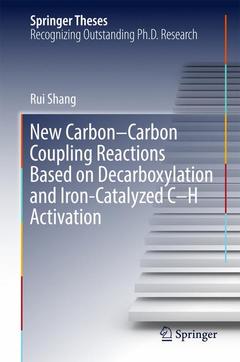Description
New Carbon–Carbon Coupling Reactions Based on Decarboxylation and Iron-Catalyzed C–H Activation, 1st ed. 2017
Springer Theses Series
Author: Shang Rui
Language: English
Subjects for New Carbon–Carbon Coupling Reactions Based on...:
Publication date: 12-2016
Support: Print on demand
Publication date: 07-2018
Support: Print on demand
Description
/li>Contents
/li>Comment
/li>
This thesis presents the latest developments in new catalytic C?C bond formation methods using easily accessible carboxylate salts through catalytic decarboxylation with good atom economy, and employing the sustainable element iron as the catalyst to directly activate C?H bonds with high step efficiency. In this regard, it explores a mechanistic understanding of the newly discovered decarboxylative couplings and the catalytic reactivity of the iron catalyst with the help of density functional theory calculation.
The thesis is divided into two parts, the first of which focuses on the development of a series of previously unexplored, inexpensive carboxylate salts as useful building blocks for the formation of various C?C bonds to access valuable chemicals. In turn, the second part is devoted to several new C?C bond formation methodologies using the most ubiquitous transition metal, iron, as a catalyst, and using the ubiquitous C?H bond as the coupling partner.
Introduction to Carbon-Carbon Coupling Reactions Based on Decarboxylation and Iron-Catalyzed C-H Activation.- Part I New Carbon-Carbon Bond Formation Methodologies Based on Decarboxylation.- Transition-Metal-Catalyzed Decarboxylation and Decarboxylative Cross-Couplings.- Palladium-Catalyzed Decarboxylative Coupling of Potassium Oxalate Monoester with Aryl and Alkenyl Halides.- Synthesis of Polyfluorobiaryls via Copper-Catalyzed Decarboxylative Couplings of Potassium Polyfluorobenzoates with Aryl Bromides and Iodides.- Palladium-Catalyzed Decarboxylative Couplings of Potassium Polyfluorobenzoates with Aryl Bromides, Chlorides and Triflates.- Construction of C(sp3)-C(sp2) Bonds via Palladium-Catalyzed Decarboxylative Couplings of 2-(2-Azaaryl)acetate Salts with Aryl Halides.- Synthesis of α-Aryl Nitriles and α-Aryl Acetate Esters via Palladium-Catalyzed Decarboxylative Couplings of α-Cyano Carboxylate Salts and Malonate Monoester Salts with Aryl Halides.- Palladium-Catalyzed Decarboxylative Couplings of Nitrophenyl Acetate Salts and Its Derivatives with Aryl Halides.- Palladium-Catalyzed Decarboxylative Benzylation of α-Cyano Aliphatic Carboxylate Salts with Benzyl Electrophiles.- Part II New Carbon-Carbon Bond Formation Methodologies Based on Iron-Catalyzed C-H Activation.- Recent Develpments of Iron-Catalyzed Directed C-H Activation/C-C Bond Formation Reactions.-β-Arylation of Carboxamides via Iron-Catalyzed C(sp3)–H Bond Activation.- Iron-Catalyzed C(sp2)–H and C(sp3)–H Bond Functionalization with Organoboron Compounds.
These books may interest you

C-H Activation 316.49 €



